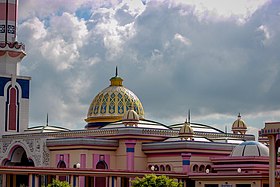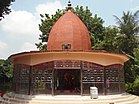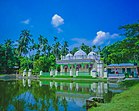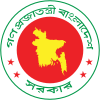|
Barisal District
Barisal District, officially spelled Barishal District from April 2018,[5] is a district in south-central Bangladesh, formerly called Bakerganj district, established in 1797.[6] Its headquarters are in the city of Barisal, which is also the headquarters of Barisal Division.[7] HistoryThe early history of Barisal district is less well-known. It was likely slowly built over time from silt from the Padma, Jamuna and Meghna Rivers. Barisal was part of the early empires of Bengal like Palas and Senas. A copper plate has been found in present Mehendiganj upazila showing a land grant made to a Brahmin by Keshab Sen. However, the Hindu kings only controlled the northern part of the district, while dense forests covered the southern part and isolated the inhabitants from outside influence. After the conquest of the Senas by Bakhtiyar Khilji, various Hindu nobles spread out over the eastern delta. The royal family of Chandradwip, also called Bakla, was originally one of these families. Throughout the period of the Bengal sultanate, the rulers of Chandradwip managed to retain somewhat of their independence. However, when the Mughals overthrew the Bengal Sultanate in 1576, they began to reorganise the province for easier governance. In the Ain-i-Akbari, the Bakla Sarkar of the Bengal Subah included present-day Barisal division. However the rulers of Chandradwip were still independent and were part of the Baro-Bhuiyans of Bengal. In 1584, Abul Fazl recorded a large stormwave impacting Chandradwip which he says killed the king and 2,00,000 of his subjects.[8] At this time, the Barisal region was subjected to the raids of the Maghs supported by the Portuguese. Portuguese mercenaries were employed by the Raja of Chandradwip, but they mainly aided the King of Arakan in raiding the Meghna estuary. After a force of Portuguese pirates was defeated by the Mughals in 1608 in the Meghna, Sebastian Gonzales Tilao, with the support of the Raja of Chandradwip, took over Sandwip. Although they had agreed to divide the revenue of the island, Tilao soon betrayed his ally and began raiding the eastern part of Chandradwip. In 1615, the Arakanese took back Sandwip, but they soon extended their own piracy to Chandradwip and caused a mass flight of nobles to Madhabpasha in present Babuganj Upazila.[8] In 1639, Shah Shuja defeated the Maghs in battle in present Jhalokati district and built a ring of forts to the south of Barisal largely in present Jhalokati district to protect the region from Magh attacks. After this time, the Barisal region passed under direct Mughal control and the Chandradwip rajas faded into obscurity, with much of the southern part of the district being cleared and settled by mainly Muslim pirs who spread their Islamic cosmology among the local tribes of the region.[8] The early 18th century was tumultuous for the district due to the movement of the Subah capital from Dhaka to Murshidabad. Adventurers began preying on existing Zamindars. One of these was Aga Bakhar, who had suppressed a rebellion of a Hindu zamindar. In 1730, he became Governor of Chittagong and lived in Dhaka. In 1753, he assassinated a naib nazim and was killed himself a day later. Aga Bakhar's heir inherited his land in Selimabad but was overthrown by the Naib Nazim Nowaris Muhammad, advised by his diwan Raja Rajallabh. He was killed by Mir Qasim after the Battle of Plassey. At this time the Maghs also restarted their raids so that in British records the southern part of Barisal Division is depopulated. Barisal District traces its origins to Bakerganj district which was established in 1797. It was placed in Barisal Division on 1 January 1993.[6] Demographics
At the 2022 Census, Barisal District had 629,626 households and a population of 2,570,446 with an average 4.02 people per household. Among the population, 475,192 (18.49%) inhabitants were under 10 years of age. The population density was 923 people per km2. Barisal District had a literacy rate (age 7 and over) of 79.85%, compared to the national average of 74.80%, and a sex ratio of 1047 females per 1000 males. Approximately, 30.23% of the population lived in urban areas. The ethnic population was 843.[3] Religion
Islam is the predominant religion in the district with a Hindu minority composed mainly of Namasudras along with an even smaller Christian minority. The northwestern part of erstwhile Bakerganj district along with Gopalganj subdivision of Faridpur district were the only large part of East Bengal where Hindus outnumbered Muslims during the British era. However since partition, Hindus have been fleeing the district in large numbers, mainly to India, especially after major violence in 1950 and 1964 and during the independence war. Among the 10 upazilas of the district, the Agailjhara Upazila has the highest percentage share of Hindus at 40 per cent, while the Muladi Upazila has the lowest at just 1.7 per cent, according to the 2022 Bangladesh census. Christians mainly live in northwestern Barisal and converted from Namasudras during the British period. SubdivisionsBarisal District is divided into the following Upazilas (formerly called Thanas) along with Barishal City Corporation: VillagesEducationNotable educational institutions in Barisal include
Notable personalities
See alsoNotes
ReferencesWikimedia Commons has media related to Barishal District.
|
||||||||||||||||||||||||||||||||||||||||||||||||||||||||||||||||||||||||||||||||||||||||||||||||||||||||||||||||||||||||||||||||||||||||||||||||||||||||||||||||||||||||||||||













